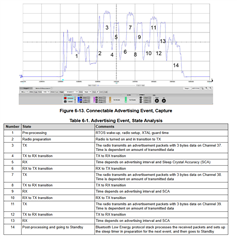Other Parts Discussed in Thread: ENERGYTRACE
Hi,
To improve the accuracy of packet timestamps in proprietary mode, is it possible to increase the RAT count rate to 48MHz using an override?
This thread has been locked.
If you have a related question, please click the "Ask a related question" button in the top right corner. The newly created question will be automatically linked to this question.
Hi,
To improve the accuracy of packet timestamps in proprietary mode, is it possible to increase the RAT count rate to 48MHz using an override?
Hi,
We do not have such an override to offer.
However, that E2E post could help you: https://e2e.ti.com/support/wireless-connectivity/sub-1-ghz-group/sub-1-ghz/f/sub-1-ghz-forum/736339/cc1350-working-of-radio-receive-timestamp-algorithm
Regards,
Arthur
Hi Arthur,
Thank you for your reply. After reading the other post, I understand that the timestamp accuracy is limited to 1/4 of symbol rate due to correlator sample rate, and there is an additional ±125ns uncertainty because the RAT is not synchronous with the correlator. When routing RATGPO1 to an output pin, will the output be the instantaneous output of the correlator, or is it sampled according to the RAT tick?
Hi Adam,
I am currently checking with the Radio team to find an answer.
Regards,
Arthur
Hi Adam,
After double checking with the team, we found out that the sync signal is indeed sampled according to the Radio Timer.
Regards,
Arthur
Hi Arthur,
Could you double check with the Radio team if there's a prescaler control register on the radio that could be set with an override to increase the Radio Timer count rate?
Hi Adam,
There is no such override. The Radio Timer is a fixed 4 MHz.
Regards,
Arthur
Hi Arthur,
OK. I understand that when receiving, timestamp accuracy is limited by the correlator sample rate and the Radio Timer clock alignment with the correlator. What is the situation when transmitting? When using a start trigger to control the transmission start time, is the modulator clock synchronized with the Radio Timer, or is there delay uncertainty due to the alignment of the Radio Timer with the modulator clock?
Hi Adam,
I have to verify that with other members of the team. In the meantime, I think you could try to characterize that delay (if it exists) by measuring the power consumption of the device, either using a DC Power Analyzer or using EnergyTrace.
That graph might help you, although related to BLE:

It comes from the following app note: https://www.ti.com/lit/an/swra478d/swra478d.pdf
Regards,
Arthur
Also,
Are you, by any chance, trying to implement some sort of Time-Of-Flight measurement?
Hi Adam,
Please can you mention how you plan to time stamp the tx message and what is the accuracy of timestamps you are looking for in your application? The RAT timer is indeed used during scheduling of transmissions, but to know in more detail regarding any delays between the timer and the modulator, we need feedback from RnD. We will get back to you next week.
Regards,
Sid
Hi Sid,
Presumably we would be initiating a CMD_PROP_TX radio command using a TRIG_ABSTIME trigger. The Tx message time would then be the specified startTime plus the known offset from trigger to transmit. However, we are open to a different method if it would improve the accuracy.
I would like to understand all sources of timing uncertainty and how to reduce or eliminate them. Due to NDA, I can't provide more application details in a public forum.
Hi Adam,
Sorry for the delays for response on our end.
In the technical reference manual, you can check the section 25.2.3 RF Core Interrupts. These interrupts can be used to find the time between various radio events which could be helpful to get the delays in transmission from the time it was scheduled.
https://dev.ti.com/tirex/explore/node?node=AJKjn1fr2ez-kYQ5ZBaSXA__coGQ502__LATEST
The expert on this is out of office at the moment and going to be back on Monday. We can provide a more detailed answer then.
Regards,
Sid
Hi Sid,
That's wrong, but thanks for trying. The CPE interrupts have limited value for timing purposes since they're basically just bit-banged GPIOs from the RF Core. The RF hardware interrupts aren't documented it's so there's no way of knowing how any of them relate to transmission timing. (I mean, I know MDMSOFT corresponds to sync word detection, but that's not specified in the manual, and it doesn't tell me anything about transmit timing.) And anyway, there's no reason to look at any of that when the modulator input signal is directly available on MCE_GPO0. Furthermore, that doesn't answer my question as to whether the modulator clock is aligned with the RAT clock.
I have been advised by my colleague not to seek further information from TI.
Hi Adam,
OK. I understand that when receiving, timestamp accuracy is limited by the correlator sample rate and the Radio Timer clock alignment with the correlator. What is the situation when transmitting? When using a start trigger to control the transmission start time, is the modulator clock synchronized with the Radio Timer, or is there delay uncertainty due to the alignment of the Radio Timer with the modulator clock?
According to the radio expert, there is no uncertainty at all. The transmission will start at a fixed offset from the programmed start time.
I believe the radio expert may be mistaken. Suppose, for example, you set the bitrate to 750kbps... The transmission can't possibly start at a fixed offset from the programmed start time, because the modulator clock will randomly be at one of three possible phase offsets from the RAT clock, a different offset for every transmission.